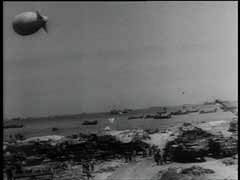<< Previous | Displaying results 1851-1875 of 6719 for "" | Next >>
-
Jewish refugees trapped in no-man's-land
FilmAfter the Munich agreement and the Czech surrender of the Sudetenland to Germany, German authorities expelled these Jewish residents of Pohorelice from the Sudetenland to Czechoslovakia. The Czech government, fearing a flood of refugees, refused to admit them. The Jewish refugees were then forced to camp in the no-man's-land between Bruno and Bratislava on the Czech frontier with Germany.
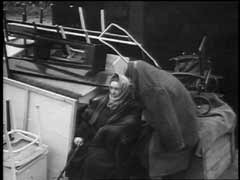
-
Evian Conference fails to aid refugees
FilmDelegates of 32 countries assembled at the Royal Hotel in Evian, France, from July 6 to 15, 1938, to discuss the problem of Jewish refugees. The refugees were desperate to flee Nazi persecution in Germany, but could not leave without having permission to settle in other countries. The Evian Conference resulted in almost no change in the immigration policies of most of the attending nations. The major powers--the United States, Great Britain, and France--opposed unrestricted immigration, making it clear…
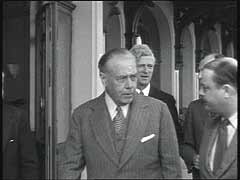
-
Jewish refugees cross into Italy
FilmThe postwar movement of about 250,000 mainly eastern European Jewish survivors to displaced persons camps and to the West, with the goal of reaching Palestine, was known as the "Brihah" ("flight"). Here, Jewish refugees cross illegally into Italy, probably to charter a ship to sail to Palestine. The British restricted Jewish immigration into Palestine and deported "illegal" immigrants to detention camps in Cyprus.
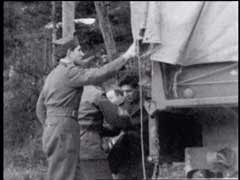
-
Defendants enter pleas at Nuremberg Trial
FilmAfter the defeat of Germany, the Allies tried leading state and party officials and military commanders of the Third Reich before a tribunal of military judges from the Soviet Union, Great Britain, France, and the United States. This International Military Tribunal tried 22 major war criminals during what is commonly known as the Nuremberg Trial, which lasted from November 1945 to October 1946. This footage shows the accused entering pleas following their indictment on charges of crimes against peace, war…

-
Nuremberg Trial: Göring testifies
FilmHermann Göring was head of the German air force. He was one of 22 major war criminals tried by the International Military Tribunal at Nuremberg. Here, Göring testifies about his order of July 31, 1941, authorizing Reinhard Heydrich, head of the Reich Security Main Office, to plan a so-called "solution to the Jewish question in Europe." The Tribunal found Göring guilty on all counts and sentenced him to death. Göring committed suicide shortly before his execution was to take place.
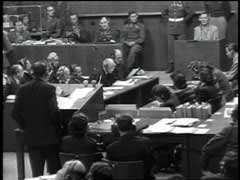
-
Victims of medical experiments testify during Medical Case
FilmThe Medical Case was one of 12 war crimes trials held before an American tribunal as part of the Subsequent Nuremberg Proceedings. On trial were doctors and nurses who had participated in the killing of physically and mentally impaired Germans and who had performed medical experiments on people imprisoned in concentration camps. Here, concentration camp survivors Maria Kusmierczuk and Jadwiga Dzido, who had been victims of these experiments, show their injuries to the court as evidence.
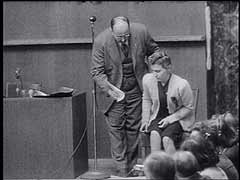
-
Einsatzgruppen trial: US prosecution opens case against Einsatzgruppen members
FilmAfter the trial of major war criminals before the International Military Tribunal in Nuremberg, the United States held a series of other war crimes trials at Nuremberg—the Subsequent Nuremberg Proceedings. The ninth trial before the American military tribunal in Nuremberg focused on members of the Einsatzgruppen (mobile killing units), who had been assigned to kill Jews and other people behind the eastern front. This footage shows US prosecutor Ben Ferencz outlining the purpose of the trial during…
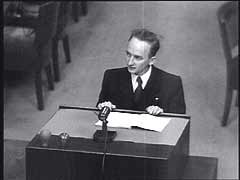
-
Einsatzgruppen trial: US prosecution condemns genocide
FilmAfter the trial of major war criminals before the International Military Tribunal in Nuremberg, the United States held a series of other war crimes trials at Nuremberg—the Subsequent Nuremberg Proceedings. The ninth trial before the American military tribunal in Nuremberg focused on members of the Einsatzgruppen (mobile killing units), who had been assigned to kill Jews and other people behind the eastern front. In this footage of the prosecution's opening statement, US prosecutor Ben Ferencz explains…

-
Vidkun Quisling on Trial in Norway for War Crimes
FilmVidkun Quisling headed the German-controlled government of Norway from 1942-1945. Because of his actions, his name became synonymous with Nazi collaboration.
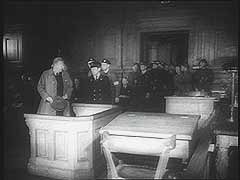
-
Hitler campaign speech
FilmNazi supporters parade at a campaign rally in Waldenburg, Germany. In a speech, Hitler attacks the Weimar Republic and pledges to dissolve the parliamentary system soon after he gains power.
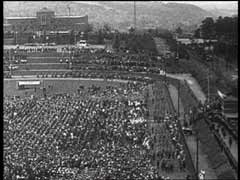
-
Books burn as Goebbels speaks
FilmIn their drive to rid the country of all that they deemed "un-German," the Nazis publically burned books in cities across Germany. Here in front of the Opera House in Berlin, a chanting crowd burns books written by Jews and leftist intellectuals. Joseph Goebbels, Hitler's minister of propaganda and public information, speaks of the intended "reeducation" of Germany.

-
Germany rejects disarmament and international cooperation
FilmAdolf Hitler's foreign policy aimed at establishing a European empire for Germany through war. This policy required the rapid expansion of Germany's military capabilities. The Geneva Disarmament Conference, beginning in 1932, sought to avoid another European war by negotiating a reduction in armaments. Hitler repudiated this effort by withdrawing Germany from the conference in October 1933. At the same time, he rejected collective security in international affairs by withdrawing from the League of Nations.…
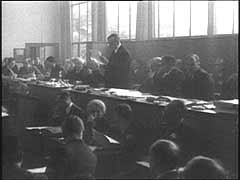
-
Remilitarization of the Rhineland
FilmProvisions of the 1919 Treaty of Versailles forbade Germany (defeated in World War I) to station armed forces in a demilitarized zone in the Rhineland—a region in western Germany bordering France, Belgium, and part of the Netherlands. The treaty stipulated that Allied forces—including US troops—would occupy the region. In a blatant violation of the treaty, on March 7, 1936, Hitler ordered German troops to reoccupy the zone. Hitler gambled that the western powers would not intervene. His action…
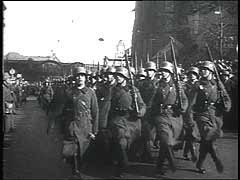
-
Opening of 1936 Summer Olympic Games
FilmIn 1933, Nazi Party leader Adolf Hitler became chancellor of Germany and quickly turned the nation's fragile democracy into a one-party dictatorship. Police rounded up thousands of political opponents, detaining them without trial in concentration camps. The Nazi regime also put into practice racial policies that aimed to "purify" and strengthen the Germanic "Aryan" population. A relentless campaign began to exclude Germany's one-half million Jews from all aspects of German life. For two weeks in August…
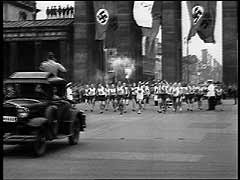
-
Liberation of Auschwitz: Belongings of victims
FilmUpon arrival in the Auschwitz camp, victims were forced to hand over all their belongings. Inmates' belongings were routinely packed and shipped to Germany for distribution to civilians or use by German industry. The Auschwitz camp was liberated in January 1945. This Soviet military footage shows civilians and Soviet soldiers sifting through possessions of people deported to the Auschwitz killing center.
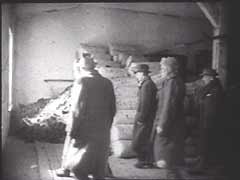
-
Romani (Gypsy) children used in racial studies
FilmEva Justin was an assistant to Dr. Robert Ritter, the Third Reich's "expert" on Roma (Gypsies). She studied these Romani (Gypsy) children as part of her dissertation on the racial characteristics of Roma. The children stayed at St. Josefspflege, a Catholic children's home in Mulfingen, Germany. Justin completed her study shortly after this film was taken. The children were deported to Auschwitz-Birkenau, where most were killed.
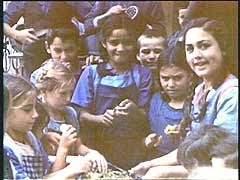
-
Exhumations at Hadamar
FilmThe Hadamar psychiatric hospital was used as a euthanasia killing center from January until August 1941. Nazi doctors gassed about 10,000 German patients there. Although systematic gassings ended in September 1941, the killing of patients continued through the end of the war. In this footage, American soldiers supervise the exhumation of the cemetery at Hadamar and begin the interrogation of Dr. Adolf Wahlmann and Karl Wilig, who participated in the killings.
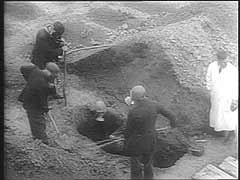
-
Aerial view of Dachau concentration camp
Film[This video is silent] The Dachau concentration camp, northwest of Munich, Germany, was the first regular concentration camp the Nazis established in 1933. About twelve years later, on April 29, 1945, US armed forces liberated the camp. There were some 30,000 starving prisoners in the camp at the time. This footage shows an aerial view of the camp and the entrance gate to the prisoner compound.
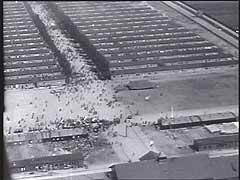
-
US soldiers inspect Hadamar
FilmIn Nazi usage, "euthanasia" referred to the killing of those whom the Nazis deemed "unworthy of life." In 1941 the Hadamar psychiatric clinic served as one of the euthanasia killing centers in Germany. Patients selected by German doctors for euthanasia were transferred to Hadamar or one of the other facilities and were killed in gas chambers. Over 10,000 people were gassed at Hadamar before the Euthanasia Program officially ended in August 1941. Although the program had officially ended, killings continued…
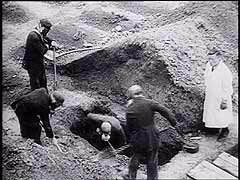
-
Einsatzgruppen trial: Justice Jackson details use of gas vans
FilmAfter the trial of major war criminals before the International Military Tribunal in Nuremberg, the United States held a series of other war crimes trials at Nuremberg during the Subsequent Nuremberg Proceedings.The ninth trial of these proceedings, before an American military tribunal, focused on members of the Einsatzgruppen (mobile killing units) who had been assigned to kill Jews and other people behind the eastern front. This footage shows US Supreme Court Justice Robert Jackson, chief prosecutor for…
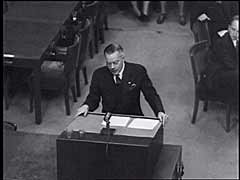
-
British army chaplain describes Bergen-Belsen upon liberation
FilmBritish troops liberated the Bergen-Belsen concentration camp in Germany in April 1945. They filmed statements from members of their own forces. In this British military footage, British army chaplain T.J. Stretch recounts his impressions of the camp.
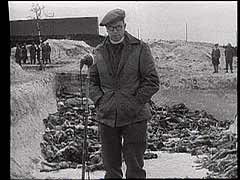
-
Kamikaze attacks on US ships, 1945
FilmJapanese pilots used the tactic of Kamikaze (suicidal) dive-bombing attacks on enemy warships in 1944 and 1945. The "USS Nevada," despite an escort and efforts to fight off a Kamikaze attack, sustained such a hit in early 1945 off the coast of Japan. The "USS Ticonderoga," a carrier, also sustained such a hit in early 1945 off Formosa (Taiwan). The impact of Kamikaze attacks decreased during the final months of the war in the Pacific, in part because of an improvement in Allied evasion tactics.
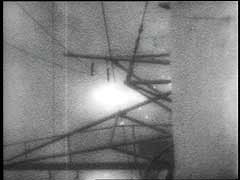
-
Fighting in the Philippines
FilmJapanese forces took the Philippine islands between December 1941 and May 1942. After US naval victory in the Battle of Midway (June 1942), Allied forces slowly gained naval and air supremacy in the Pacific war. In October 1944, US forces began the liberation of the Philippines. The campaign on Luzon, largest and most northern of the islands, began in December 1944. This battle footage shows many Japanese soldiers being taken as prisoners of war.
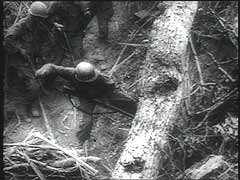
-
Japanese surrender
FilmWorld War II in the Pacific theater ended with the Japanese surrender on September 2, 1945. The surrender was signed in Tokyo Bay aboard the American battleship USS "Missouri." Foreign Minister Shigemitsu headed the Japanese delegation. General Douglas MacArthur accepted the surrender on behalf of the Allies. Admiral Nimitz signed for the US and Admiral Fraser for Britain. Representatives of all the Allied nations attended the signing.

-
D-Day
FilmMassive Allied landings of air- and sea-borne forces on five Normandy beaches (codenamed Utah, Omaha, Gold, Juno, and Sword) began on June 6, 1944 (D-Day). The purpose of the invasion was to establish a bridgehead from which Allied forces could break out and liberate France. By the end of the operation's first day, some 150,000 troops were ashore in Normandy. This footage shows Allied forces landing on the Normandy beaches.
